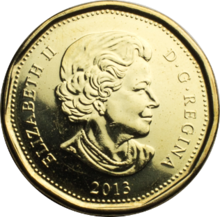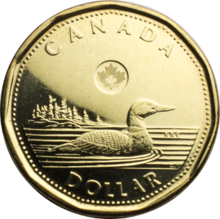This article has multiple issues. Please help improve it or discuss these issues on the talk page. (Learn how and when to remove these template messages)
|
Canada | |
| Value | 1 CAD |
|---|---|
| Mass | 6.27 g |
| Diameter | 26.5 mm |
| Thickness | 1.95 mm |
| Edge | Eleven-sided, smooth, 7.5 mm |
| Composition | Steel, brass plating |
| Years of minting | 1987–present |
| Catalogue number | – |
| Obverse | |
 | |
| Design | Elizabeth II, Queen of Canada |
| Designer | Susanna Blunt |
| Design date | 2003 |
| Design discontinued | 2023 |
| Design | Charles III, King of Canada |
| Designer | Steven Rosati |
| Design date | 2023 |
| Reverse | |
| Design | Common loon in water |
| Designer | Robert-Ralph Carmichael[1] |
| Design date | 1987 |
 | |
| Design | Common loon in water |
| Designer | Robert-Ralph Carmichael |
| Design date | 2012 |
The loonie (French: huard), formally the Canadian one-dollar coin, is a gold-coloured Canadian coin that was introduced in 1987 and is produced by the Royal Canadian Mint at its facility in Winnipeg. The most prevalent versions of the coin show a common loon, a bird found throughout Canada, on the reverse and Queen Elizabeth II, the nation's head of state at the time of the coin's issue, on the obverse. Various commemorative and specimen-set editions of the coin with special designs replacing the loon on the reverse have been minted over the years. Beginning in December 2023, a new version featuring King Charles III entered circulation, to replace the version featuring Elizabeth II.
The coin's outline is an 11-sided Reuleaux polygon. Its diameter of 26.5 mm and its 11-sidedness matched that of the already-circulating Susan B. Anthony dollar in the United States, and its thickness of 1.95 mm was a close match to the latter's 2.0 mm. Its gold colour differed from the silver-coloured Anthony dollar; however, the succeeding Sacagawea and Presidential dollars matched the loonie's overall hue. Other coins using a non-circular curve of constant width include the 7-sided British twenty pence and fifty pence coins (the latter of which has similar size and value to the loonie, but is silver in colour).
After its introduction, the coin became a metonym for the Canadian dollar: media often discuss the rate at which the loonie is trading against other currencies.[2] The nickname loonie became so widely recognized that in 2006, the Royal Canadian Mint secured the rights to it.[3] When the Canadian two-dollar coin was introduced in 1996, it was in turn nicknamed the "toonie" (a portmanteau of "two" and "loonie").
- ^ "1 dollar". Royal Canadian Mint. Retrieved November 26, 2022.
- ^ "Loonie trading lower against U.S. dollar". CBC News. April 21, 2003. Retrieved November 26, 2022.
- ^ "Application Number: 0916677". Canadian Trade-marks Database. Canadian Intellectual Property Office. Retrieved February 18, 2010.
